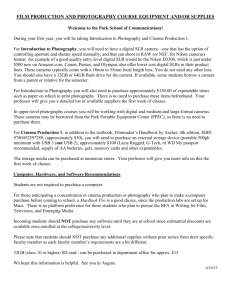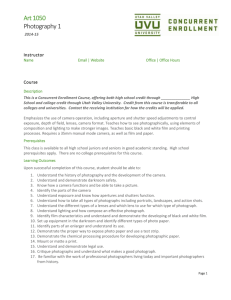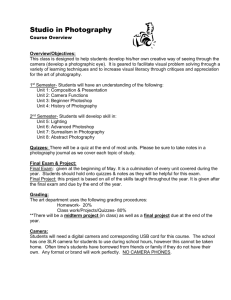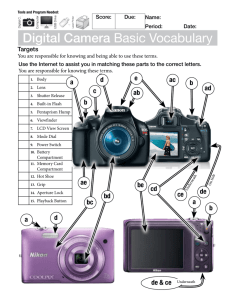File - St James Visual Arts
advertisement
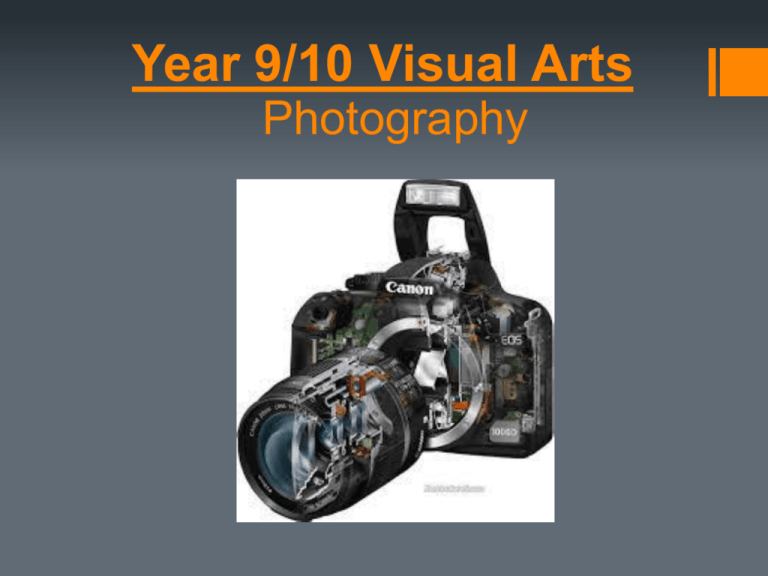
Year 9/10 Visual Arts Photography Year 9/10 Visual Arts Photography Term 1 Overview Unit 1 – (9 weeks) Photography and mixed media Making Task – Design a school magazine or Diary cover. Written Task – Research Written Task History of Photography Photography saw many different camera designs and configurations – the early heavy-plate cameras were replaced by smaller box cameras, which would eventually lead to the modern single-lens reflex design. 1900-1920 Film: Plates Now let’s go back to the beginning and look at the history of photography. It had long been known how to project an image onto a surface. If one placed an object in front of a small hole, later a lens, outside a darkened room without windows, light rays would reflect off the object, through the hole, and create a reversed image on the opposite wall. But it wasn’t until 1826 that Nicephore Niepce invented a method of retaining this image forever. Camera obscura ( means dark room) Trap door In 1646, Athanasius Kircher (1601-1680) described a camera obscura which consisted of an outer shell with lenses in the centre of each wall, and an inner shell containing transparent paper for drawing. The artist would enter by a trapdoor. A typical portable camera obscura at the beginning of the 19th century incorporating a mirror (a), which reflects the image from the lens (b) onto a glass plate (c) which holds a sheet of paper on which the image is being traced. 17th century: Portable camera obscuras were frequently used by artists to help draw images. But it wasn’t until 1827 that Nicephore Niépce invented a method of retaining this image forever. In 1725 the German professor J. Schulze mixed chalk, nitric acid and silver in a flask. He noticed darkening on side of the flask exposed to sunlight. He had accidentally created the first photo-sensitive compound. In 1827 Nicéphore Niépce (pronounced Nee-ps) made the world’s oldest existing photograph by exposing a tin plate coated with a lightsensitive varnish inside a camera obscura for 8 hours . () 1827: Niépce created the first permanent photographic image. View from Niepce’s Window at Le Gras. A building is on the left, a tree a third in from the left, and a barn immediately in front. The exposure lasted eight hours, so the sun had time to move from east to west, appearing to shine on both sides of the building. Niépce called his images heliographs (sun drawings). Prior to the invention of photography, all portraits had to be meticulously painted. Napoleon on his Imperial Throne by Ingres (1780– 1867), painted in 1806. 1834: Henry Fox Talbot created permanent (negative) images using paper coated with salt and silver compound fixed with salt water. “Talbot then placed this negative image over a sheet of prepared paper and exposed it to light, producing a positive image on the second sheet of paper.” Talbot had thus invented the process of printing positive images from negative exposures – this process eventually took over from any other and is the direct predecessor of modern analogue photography. One of Daguerre’s first views of Paris. At first, exposure times of 15 minutes in bright sunlight were needed but this was later reduced to between 10 and 60 seconds. The daguerreotype was made public in Europe in 1839 and the technology quickly spread to other countries. The daguerreotype was the first practical and commercial photographic process. Daguerreotypes were fragile, expensive to produce and exuded a magical quality. Daguerreotype of a "Chinese woman," identified as Miss Pwan Ye Koo c. 1850s Lorenzo G. Chase, photographer The surfaces were extremely delicate, which is why they are often found housed under glass in a case. The image was reversed laterally, the sitter seeing himself as he did when looking at a mirror. (Sometimes the camera lens was equipped with a mirror to correct this). The chemicals used (bromine and chlorine fumes and hot mercury) were highly toxic. Exposure times were over 60 seconds, so this little girl, her pony and servant, were required to stay as still as possible while the image was taken Photography is became useful to capture events as they unfolded over a shorter period of time. 1871: Richard Leach Maddox, an English doctor, proposes the use of an emulsion of gelatin and silver bromide on a glass plate, the "dry plate" process. 1878: Dry plates being manufactured commercially. George Eastman developed both the transparent roll of film, and the Kodak Box Brownie, in 1888, which took 5.7 cm square pictures on a roll of film. Alfred Steiglitz From the BackWindow, 291 (1915) 1907: First commercial color film, Autochrome plates, manufactured by Lumiere brothers in France 1917: Nippon Kogaku K.K. which eventually became Nikon, was established in Tokyo. First Nikon camera: The Nikon 1 1931: Development of strobe photography by Harold ("Doc") Edgerton at MIT whereby a strobe light could flash up to 120 times a second. A droplet is caught with a strobe after rebounding upward In 1935 Kodak introduced the first modern colour film, Kodachrome. 1947: Henri Cartier-Bresson, Robert Capa, and David Seymour start the photographer-owned Magnum picture agency Speedgraphic Camera Standard equipment for press photographers in the 1960s Instamatic cameras by Kodak introduced in 1963. These cheap, easy-to-load 126 and 110 cameras were extremely successful, introducing a generation to low-cost photography. The name Instamatic is still used, mistakenly, to refer to any inexpensive “point and shoot” camera. 1963: First color instant film developed by Polaroid Polaroid SX-70 Land Camera (1972) With the SX-70 you could just point, shoot, and watch the image develop before your eyes. It was the first Polaroid to automatically eject the snapshot and produce images, without making you wait 60 seconds and peel off the outer wrapper of the film. The SX-70 combined simplicity with immediacy, making it the direct forebear of today's low-end digital cameras. In 1975 Eastman Kodak engineer Steve Sasson built the first working CCD-based (charge coupled device) digital still camera. The prototype weighed 3.6kilogram and was the size of a toaster. In 1976, the Museum of Modern Art in New York held a show by William Eggleston. At this moment Photography becomes accepted by the artworld as an art form. Untitled 1962 - 68 1990 1994 Adobe Photoshop 1.0 released. Adobe Photoshop 3.0 “Photoshop has been a killer app since its introduction on the Mac in 1988, but it wasn't until years later that this watershed graphics tool became a must-have for design professionals. That adoption began in earnest with Photoshop 3.0 and the introduction of layers, which allowed designers to play with images and effects on multiple levels, one atop another, rather than in a single flat dimension. The 50 Greatest Gadgets of the Past 50 Years This technology opened the door for image manipulation on a much grander scale than had been possible before--and it's also why you'll never be able to trust a photograph again.” In 1991 the Kodak Professional Digital Camera System or DCS, was the first commercially available DSLR camera. It was mounted on a Nikon F3 body . Aimed at the photo journalism market in order to speed up the transmitting of pictures back to the studio or newsroom, the DCS had a resolution of 1.3 megapixels. The 1991-era Kodak DCS-100 with accessories. “Digital SLRs are often preferred by professional still photographers because they allow an accurate preview of framing close to the moment of exposure, and because DSLRs allow the user to choose from a variety of interchangeable lenses. Most DSLRs also have a function that allows accurate preview of depth of field”. An image with a shallow depth of field Depth of field is the range of distance within the subject that is acceptably sharp. Understanding Depth of Field in Photography In 1994 Kodak and Apple had a joint venture to create the Apple QuickTake, the first digital camera marketed for home use and general consumers in mind. The $750 US Quicktake 100 was able to capture eight 640×480 resolution images and easily transferred the images to home computers. Shortly after the release of the Quicktake 100, a number of other cameras marketed for home use were released — and digital photography would no longer be limited to the professionals. Quicktake 100 In 1999 Nikon announced the D1. It cost $5,000 US. With its megapixel rating of 2.7 it was the first DSLR with good enough image quality for print. Sharp’s J-SH04 was the world's first camera phone and was launched in Japan in 2000. Since early in the 21st century the majority of cameras and of mobile phones in use are camera phones. Camera phone photo, London Underground, 07/07/05 Most camera phones are simpler than separate digital cameras. Their usual fixed focus lenses and smaller sensors limit their performance in poor lighting. 2001: Polaroid went bankrupt. Another company took the name Polaroid Corporation. It stopped making Polaroid cameras in 2007 and stopped selling Polaroid film after 2009. Andy Warhol and ever-present Polaroid camera In 2004 Kodak ceased production of film cameras. Photographer Steve McCurry captured this image of Afghan orphan Sharbat Gula in 1984 using Kodachrome. He will shoot one of the last reels of this historic film and donate the pictures to a museum honouring Kodak founder George Eastman. The Kodachrome Project In 2005 Canon released the EOS 5D, The first consumerpriced full-frame digital SLR, with a 24x36mm CMOS sensor, for $3000. Both CCD and CMOS image sensors start at the same point - they have to convert light into signals which is than converted into digital data. An image sensor is a device that converts an optical image into an electronic signal. A CCD (charge-coupled device) image sensor is an analogue device. When light strikes the chip it is held as a small electrical charge in each photo sensor. The charges are converted to voltage one pixel at a time as they are read from the chip. Additional circuitry in the camera converts the voltage into digital information. A CMOS imaging chip is a type of active pixel sensor made using the CMOS semiconductor process. Extra circuitry next to each photo sensor converts the light energy to a voltage. Additional circuitry on the chip may be included to convert the voltage to digital data. Neither technology has a clear advantage in image quality. complementary-symmetry metal–oxide–semiconductor September 2010 Canon has announced it has successfully developed an CMOS sensor that delivers an image resolution of approximately 120 megapixels (13,280x9184 pixels) This is 12,000 times the resolution of the prototype Kodak digital camera. World Press Photo of the Year 2009 by Pietro Masturzo, Italy From the rooftops of Tehran, June World Press Photo is sponsored worldwide by Canon and TNT and the exhibition has been brought to Sydney by Canon Australia.


